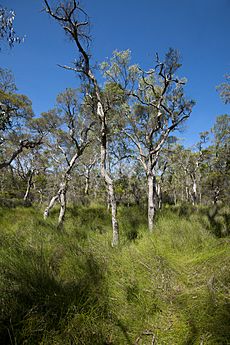Bushland facts for kids
Bushland is a term for areas of land that still have their original plants and trees. Even if the land has been disturbed, it usually keeps most of its natural plant life and structure. It's like a piece of nature that hasn't been completely changed by people.
Many stories in Australia are about people surviving in the bush. These include tales of famous Aboriginal trackers and bushrangers. People have traditionally used bushland for wood and for finding food, called bushfood.
Bushland helps our environment in many ways. It keeps our water clean and stops soil from washing away (erosion). It can also act as a windbreak and helps keep important nutrients in the soil. However, bushland areas can easily catch fire, leading to bushfires. This is a big challenge, especially as more homes and buildings are built near these natural areas.
Why Is Bushland Important?
Bushland is very important for many reasons. It provides homes for many different animals and plants. It also helps keep our air clean and supports healthy ecosystems. Without bushland, many species could lose their homes.
Protecting Bushland Areas
For a long time, Australia was clearing a lot of its natural land. This meant many bushland areas were destroyed. But since 2006, the amount of land clearing has gone down a lot. This is partly because of new laws. For example, in Queensland, it became illegal to clear large areas of mature bushland in 2006. These laws were expanded in 2009 to protect regrowing bushland that is very important for nature.
In New South Wales, bushfires cause the most damage to bushland. After fires, the biggest threats are land clearing for farms, grazing animals, roads, and buildings.
Saving Koala Habitats
Many groups are working hard to protect bushland. In Brisbane, the Brisbane City Council started a special program in 1990. This program buys bushland to protect it, especially for koalas. It is paid for by a small fee from local residents. Koalas need bushland to live and find food. Sadly, the koala population in that area has dropped a lot. It went from about 6,240 koalas in 1996 to only 1,500 in 2012. Protecting bushland is key to helping these amazing animals survive.



